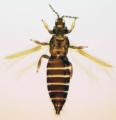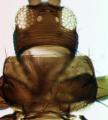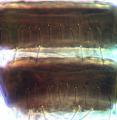Thrips obscuratus
Recognition data
Distinguishing features
Both sexes fully winged. Body brown, legs brown with tarsi yellow; antennal segment III light brown, remaining segments dark brown; fore wings brown with base sharply paler. Head wider than long; 2 pairs of ocellar setae, pair III as long as lateral margin of ocellar triangle, arising just outside triangle; postocular setae pairs I, III and V about as long as ocellar setae III. Antennae 7- or 8-segmented; segments III–IV distinctly constricted at apex, sensorium forked; VII short. Pronotum with 2 pairs of long posteroangular setae; posterior margin with 3 pairs of setae. Metanotum with closely spaced, anastomosing, longitudinal striae on posterior half; median setae arise behind anterior margin; campaniform sensilla present. Fore wing first and second veins with complete rows of setae. Abdominal tergite II with 3 lateral marginal setae; tergites V–VIII with ctenidia present laterally, on VIII posteromesad to spiracles; tergite VIII posteromarginal comb complete, microtrichia widely-spaced, slender, sometimes irregular; pleurotergites with 2 or 3 discal setae. Sternites II–VII with 3 pairs of marginal setae; II without discal setae, III–VII with 6–14 discal setae.
Male smaller than female, light brown; tergite VIII marginal comb weakly developed; tergite IX setae S1 much longer and stouter than S2 and arising anterior to these setae; sternites III–VII each with transversely oval pore plate, discal setae arising laterally.
Related and similar species
This polyphagous New Zealand species is not known from California, but is included here because it has the potential to be introduced. T. obscuratus is unusual within the genus Thrips for having three instead of two marginal setae on the second abdominal sternite, a character state that is shared with four species from New Zealand and three from New Caledonia (Mound & Masumoto, 2005). This genus is the second largest genus in the Thysanoptera, and currently includes, worldwide, about 285 species. All members of Thrips genus lack ocellar setae I on the head, and they all have ctenidia on tergite VIII posteromesad to the spiracles. Other characters, such as number of antennal segments, number of setae on the fore wing veins, and number of discal setae on the sternites are variable between species (Palmer, 1992; Mound & Masumoto, 2005).
Taxonomic data
Current valid name
Thrips obscuratus (Crawford JC)
Original name and synonyms
- Isoneurothrips obscuratus Crawford JC, 1941: 63
Family placement
Thripidae, Thripinae
Common names
New Zealand flower thrips
Biological data
Life history
Breeding in flowers
Host plants
Highly polyphagous, larvae having been recorded from 51 plant species including 36 plant species not native to New Zealand (Teulon & Penman, 1990).
Tospoviruses vectored
None
Crop damage
Causes damage to crops of stone fruits in New Zealand.
Distribution data
Area of origin
New Zealand
Distribution
New Zealand [not recorded from California]










